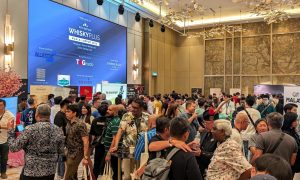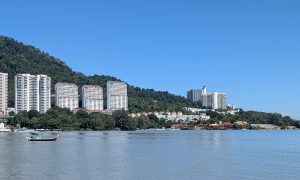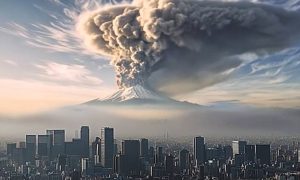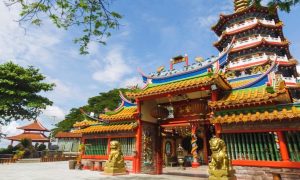Zainal Abidin Musa, a Malaysian painter, discovers the excitement of travelling to the east coast during the monsoon season and tells Anis Rozalina about his adventure at sea.
Stay alert!” Those were Lan’s grim words of caution to Along, our skipper, before we all jumped into the 14-foot fiberglass dinghy. It was a bleak morning on Perhentian Kecil Island, off the coast of Terengganu, on the last day of November in 2010. The entire sky was hanging low, crying in torrents from black menacing clouds. Huge waves were rolling in to the beach and it was impossible to imagine any kind of sea travel today!
Lan’s warning seemed feeble in the grand scheme of things, but it was the best he could offer.We only had a window of a few hours to make the treacherous journey from the island to Kuala Besut jetty before the monsoon unleashed its full onslaught upon us.
Lan and Along have made the island to-mainland journey together countless times, a trip that, in good weather, usually took only about 40 minutes. But this time, with the winds threatening to pick up ferocity, and the waves swelling to monstrous levels, we weren’t sure if we’d even reach the mainland. I was suddenly keenly aware that the monsoon had claimed many lives at sea every year.
One quick prayer, and with my trust in Along, we shot straight into the dreadful, brewing weather.There were four of us – Along, the skipper, navigated from the back; Lan,my close friend who runs a chalet operation on Perhentian Kecil Island, sat in front; Awie, a fellow artist, was in the middle. I sat at the front, next to Lan.
Along spoke up over the noise of the engine, wind, and rain, “Don’t panic and be quiet. Let me handle the boat.” As we navigated the swells of the sea, leaving behind what safety the island had provided the past two nights, I knew there was no turning back. My head toyed with the only two possible outcomes of this boat ride – we would either survive, or sink, in this sea. All I could think about was my family and wishing that I was home safe with them right that moment.
Reminiscences
Home was miles away in Seri Kembangan, where a year ago, I had thrown the idea to my wife about traveling together to the east coast to paint landscapes of the monsoon season. I had been painting fairweather landscapes of Malaysia since the 1990s, traveling to Port Klang, Janda Baik, Genting Highlands, Langkawi, Kelantan, and Mersing for inspiration and subject matter. My regular colour palette was a bright mixture of red, yellows, greens, and blues, producing brilliant landscapes of lights, shadows, sunsets, and sunrise of the places I had travelled to. This time, I was eager to see how the melancholy of the monsoon season would influence my subject matter, painting style, and colour mix.
Her idea of a monsoon trip was filled with floods, waterproof boots, raincoats and lots of puddles, while my visions leaned more to the romantic – cool weather, kampung house by the sea, painting, fishing, and endless days wandering by the wet beach.
Due to practical reasons, I made the journey not with my family but with a friend, fellow artist, Awie. I had travelled, studied, and lived in the east coast before, but painting during the monsoon would be a new experience. And that’s how I had ended up at Perhentian Kecil Island, three days earlier, painting, fishing and cooking in an almost-deserted island during a lull in the middle of the monsoon season. These brief periods of calm in between stormy days were typical during the monsoon, and I had taken my chances to paint on the island before the next storm hit.We would have spent more days there but overnight, the calm had turned turbulent, and we needed to leave or be stranded indefinitely on the island.
The boat ride back to the mainland was rough with the unrelenting waves knocking the boat and the rain pelting down, but Along was a fine skipper. His skill was gravely tested as we approached the river mouth of Kuala Besut.The waves and current at the breakwater were extremely strong, pushing the boat back to the sea over and over again. It was a critical moment that would see us steer through the waves or crash tragically into it.
Along slowed down the boat engine and waited for just the right moment to cut through the waves. He finally made a decision, revved up the engine and shot through the waters. I turned cold in my already-soaked clothes, unsure if we would make it, and just left it to fate. After harrowing seconds of struggling to ride the pounding waves, we broke through to the other side of the breakwater.What a relief! Along immediately cut the engine and let the boat just bob in the calmer waters, as our heart rates returned to normal. I never knew that there were hazards to my job as a painter, but this experience of being caught in the monsoon has certainly made quite an adventure and I’m glad to be alive to tell the story!
Seasonal Swells
To many people, the word “monsoon” conjures up images of relentless rain, ominous clouds, constant flooding, relocation of villages, deaths and aid centres to the public. The weather phenomenon is the result of the northeast winds blowing towards the east coast of Malaysia from South China Sea, whipping up waves and bringing with it heavy rainfall to the coastal areas of Pahang, Terengganu and Kelantan.The monsoon usually takes place between November and March and is characterized by nonstop rain for several days sometimes followed by clear, sunny skies briefly.
As a result, economic and leisure tourism activities come to an almost standstill as rainfall accumulates to flood certain areas, and the winds stir up the seas so that it is no longer safe to navigate. To dwellers in the east coast, most of whom still work the land and harvest the sea, this is the fact of life they face each year.There is no point in resisting the forces of nature, so instead, they embrace this respite from their months of toil on land and sea.
Making The Adjustments
But there’s more to the monsoon than just bad weather. It changes lives, yes, but it also steers it down a different path for the most part of the season. During this period, fishermen hang up their fishing nets, securely anchor their boats, and ease themselves to a more laidback lifestyle. Restless at not being able to venture out to sea as is their daily routine, they fill up their time doing repair works on their nets and boats. Coffee shops are the social gathering centres where they catch up with friends, share stories of the sea and play a few rounds of checkers. Others may huddle at the seaside wakaf in long-sleeved shirts, as though waiting to rush back to sea at the first sign of clear skies.
The womenfolk who usually work in small farms tend to other types of tasks such as sewing and meal preparation, especially pickling, salting and making sweet desserts from seasonal produce which they then sell.With friends, they would sell off whatever produce they happened to have – setting out their wares by the roadside near the market and remain there till noon (or as fair weather permits) to make any small sale. Homegrown chillies, bananas, root vegetables, and other seasonal produce are sold, as they chit-chat among themselves.
Daily diets change, too, during the monsoon. Salted fish and ikan bilis become regular accompaniments to rice, while tubers are the comfort foods during these chilly months with their wide-ranging applications in recipes. Ikan limbat, a type of catfish netted from the marshes, becomes the season’s delicacy due to the scarcity of saltwater fish during this period. It is smoked delicately to bring out some great flavours and cooked in thick coconut cream or dressed in spicy sambal. The whole affair turns into a communal feast when neighbours and friends get in on the action of catching, smoking, and cooking the fish.
Beach-combing becomes a pastime for the locals during this season. Families and friends often descend in large groups to walk along the beach and enjoy the cool breeze. It’s far too dangerous to swim, of course, but that doesn’t stop them from having picnics and passing the time idly at the seaside.
Yes, the monsoon season may be filled with rain, puddles, and dark clouds, but that hasn’t stopped the cycle of life in east coast Malaysia. Certainly the hardship is a test of their human spirit, and the local residents have overcome whatever waters come flooding down their land, whatever torrents fall from the sky in this season. Theirs is a spirit of tolerance, acceptance and, ultimately, celebration – of both the good and bad of this stormy spell – which brings fondly to mind the notion byWilla Cather that “There are some things you learn best in calm, and some in storm.”
Painting The Malaysian Monsoon
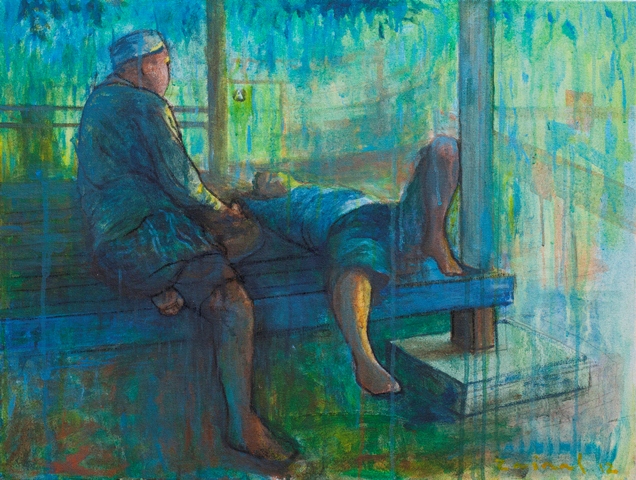
Zainal Abidin Musa’s adventures in the east coast during the monsoon season are documented in a series of paintings currently being exhibited in his solo entitled Tengkujuh. His paintings reveal an intimate view of the beauty and unique way of life during this season, seldom portrayed in the mainstream media. Having traveled to the east coast over a period of four years, he is familiar with the slices of life in this time of monsoon. Landscapes of wet beaches, rain-soaked trees, and melancholic settings are conveyed in romantic moods in the style of the Impressionists. Everyday scenes give viewers an awareness of how life goes on during this wet spell – an old fisherman looking out to sea, contemplating his next fishing expedition; a group of men resting at a wakaf, feeling restless with nothing to occupy their time; a rubber tapper sitting out the year-end showers to mend her clothes; a man braving the rain on his motorbike, with one hand holding an umbrella.
Source: Senses of Malaysia September/October 2014
Read more:
- The Monsoon Seasons in Malaysia
- An Expat’s Adventure Visiting a Longhouse in Sarawak
- Discovering Malaysia’s Gateway to the East Coast: Kuantan
What are your thoughts on this article? Let us know by commenting below. No registration needed.





